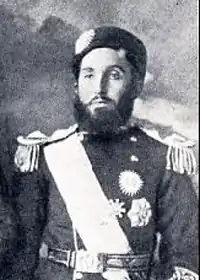Nasrullah Khan
Nasrullah Khan (auch genannt Sardar Nasrullah und auch geschrieben Nasr Ullah Khan; * 1875 in Samarkand, Russisch-Turkestan; † 31. Mai 1920 in Kabul, Afghanistan) war der langjährige Kronprinz und kurzzeitige 16. Emir von Afghanistan.

In seiner Funktion als Kronprinz vertrat er seinen damals kranken Vater und besuchte 1895 Großbritannien.[1] Dabei traf er sich mit Königin Victoria. Während seines Trips übergab er Abdul Karim, dem indischen Sekretär Victorias, ein Gastgeschenk.[2]
Nasrullah galt als ein Hāfiz und stand panislamischen Ideen nahe.[3] Er galt als ausgesprochen anti-britisch und unterstützte Gruppen jenseits der Durand-Linie in Britisch-Indien in ihrem anti-britischen Kampf.[4][5] Diese Aktivitäten forcierte er gegebenenfalls unter Duldung seines Bruders Habibullah.[6]
Im Verlauf des Ersten Weltkriegs und in der unmittelbaren Nachkriegszeit war Nasrullah Khan mit den Mitgliedern der provisorischen indischen Regierung in Kabul befreundet, der unter anderem Mahendra Pratap als Präsident und Abdul Hafiz Mohamed Barakatullah als Premierminister angehörten.[7] Auch im Ersten Weltkrieg freundete er sich mit den Mitgliedern der deutsch-osmanischen Niedermayer-Hentig-Expedition an.[8]
Er wollte 1919 als Erbe die Nachfolge seines ermordeten Bruders Habibullah Khan antreten. Wahrscheinlich standen er selbst und Mohammed Nadir Schah hinter der Ermordung.[9] Nasrullah erklärte sich zum Emir Afghanistans und Inayatullah Khan, Habibullahs Sohn, erkannte ihn an.[10] Doch Nasrullahs Neffe, Amanullah Khan, der damalige Gouverneur von Kabul, bootete ihn jedoch aus und übernahm selbst die Macht.[11][12]
Amanullah erklärte Nasrullah zum Verantwortlichen für den Tod Habibullahs.[13] Ein Jahr nach seiner Absetzung wurde er im Gefängnis ermordet – wahrscheinlich auf Befehl Amanullahs.[14]
Einzelnachweise
- 1911 Encyclopædia Britannica/Abdur Rahman Khan, en.wikisource.org (ohne Datum).
- Shrabani Basu: Victoria & Abdul: Die Queen und ihr treuester Diener – Eine wahre Geschichte, München: Goldmann Verlag 2017, S. 167.
- George Morton-Jack: The Indian Empire At War: From Jihad to Victory, The Untold Story of the Indian Army in the First World War, London: Little, Brown 2018, S. 337.
- Hugh Beattie: Empire and Tribe in the Afghan Frontier Region: Custom, Conflict and British Strategy in Waziristan until 1947, London/New York/Oxford: I.B. Tauris 2019, S. 67.
- Hugh Beattie: Empire and Tribe in the Afghan Frontier Region: Custom, Conflict and British Strategy in Waziristan until 1947, London/New York/Oxford: I.B. Tauris 2019, S. 207.
- Asta Olesen: Islam and politics in Afghanistan, Richmond: Curzon Press 1995, S. 103.
- Śrīkr̥shṇa Sarala: Indian Revolutionaries: A Comprehensive Study, 1757–1961, Band 1, New Delhi: Ocean Books 1999, S. 219.
- Ludwig W. Adamec: Historical Dictionary of Afghanistan, Lanham (MD): Scarecrow Press 2012 (4. Edition), S. 159.
- Nigel Collett: The Butcher of Amritsar: General Reginald Dyer, London: Hambledon and London 2005, S. 295.
- Ludwig W. Adamec: Historical Dictionary of Afghanistan, Lanham (MD): Scarecrow Press 2012 (4. Edition), S. 130.
- Maximilian Drephal: Afghanistan and the Coloniality of Diplomacy: The British Legation in Kabul, 1922–1948, Cham: Palgrave Macmillan 2019, S. 48.
- Ludwig W. Adamec: Historical Dictionary of Afghanistan, Lanham (MD): Scarecrow Press 2012 (4. Edition), S. 152.
- M. Nazif Shahrani: State Building and Social Fragmentation in Afghanistan: A Historical Perspective, in: Ali Banuazizi (Hg.): State, Religion, and Ethnic Politics: Afghanistan, Iran, and Pakistan, Syracuse: Syracuse University Press 1986, S. 45.
- Jack Covarrubias: Khan, Nasrullah (1874–1920), in: Tom Lansford (Hg.): Afghanistan at War: From the 18th-Century Durrani Dynasty to the 21st Century, Santa Barbara: ABC-CLIO 2017, S. 259–260 (hier: S. 260).
Literatur
- Jules Stewart: On Afghanistan's Plains – The Story of Britains's Afghan Wars. I. B. Tauris. London/New York 2011. ISBN 978-1-84885-717-9.
| Vorgänger | Amt | Nachfolger |
|---|---|---|
| Habibullah Khan | Emir von Afghanistan 21. Februar 1919 – 28. Februar 1919 | Amanullah Khan |